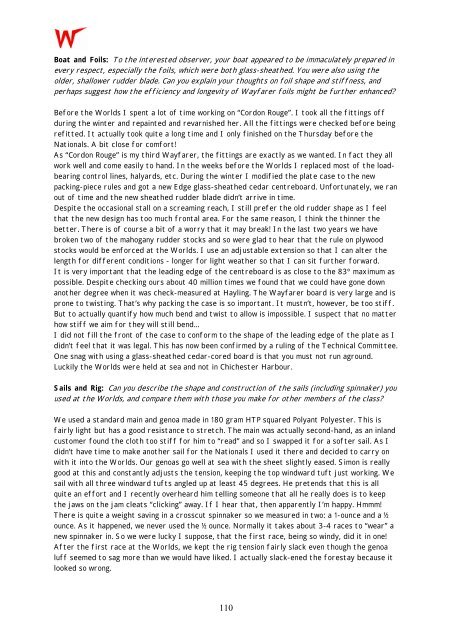File - Canadian Wayfarer Association
File - Canadian Wayfarer Association
File - Canadian Wayfarer Association
You also want an ePaper? Increase the reach of your titles
YUMPU automatically turns print PDFs into web optimized ePapers that Google loves.
Boat and Foils: To the interested observer, your boat appeared to be immaculately prepared in<br />
every respect, especially the foils, which were both glass-sheathed. You were also using the<br />
older, shallower rudder blade. Can you explain your thoughts on foil shape and stiffness, and<br />
perhaps suggest how the efficiency and longevity of <strong>Wayfarer</strong> foils might be further enhanced?<br />
Before the Worlds I spent a lot of time working on “Cordon Rouge”. I took all the fittings off<br />
during the winter and repainted and revarnished her. All the fittings were checked before being<br />
refitted. It actually took quite a long time and I only finished on the Thursday before the<br />
Nationals. A bit close for comfort!<br />
As “Cordon Rouge” is my third <strong>Wayfarer</strong>, the fittings are exactly as we wanted. In fact they all<br />
work well and come easily to hand. In the weeks before the Worlds I replaced most of the loadbearing<br />
control lines, halyards, etc. During the winter I modified the plate case to the new<br />
packing-piece rules and got a new Edge glass-sheathed cedar centreboard. Unfortunately, we ran<br />
out of time and the new sheathed rudder blade didn’t arrive in time.<br />
Despite the occasional stall on a screaming reach, I still prefer the old rudder shape as I feel<br />
that the new design has too much frontal area. For the same reason, I think the thinner the<br />
better. There is of course a bit of a worry that it may break! In the last two years we have<br />
broken two of the mahogany rudder stocks and so were glad to hear that the rule on plywood<br />
stocks would be enforced at the Worlds. I use an adjustable extension so that I can alter the<br />
length for different conditions - longer for light weather so that I can sit further forward.<br />
It is very important that the leading edge of the centreboard is as close to the 83º maximum as<br />
possible. Despite checking ours about 40 million times we found that we could have gone down<br />
another degree when it was check-measured at Hayling. The <strong>Wayfarer</strong> board is very large and is<br />
prone to twisting. That’s why packing the case is so important. It mustn’t, however, be too stiff.<br />
But to actually quantify how much bend and twist to allow is impossible. I suspect that no matter<br />
how stiff we aim for they will still bend...<br />
I did not fill the front of the case to conform to the shape of the leading edge of the plate as I<br />
didn’t feel that it was legal. This has now been confirmed by a ruling of the Technical Committee.<br />
One snag with using a glass-sheathed cedar-cored board is that you must not run aground.<br />
Luckily the Worlds were held at sea and not in Chichester Harbour.<br />
Sails and Rig: Can you describe the shape and construction of the sails (including spinnaker) you<br />
used at the Worlds, and compare them with those you make for other members of the class?<br />
We used a standard main and genoa made in 180 gram HTP squared Polyant Polyester. This is<br />
fairly light but has a good resistance to stretch. The main was actually second-hand, as an inland<br />
customer found the cloth too stiff for him to “read” and so I swapped it for a softer sail. As I<br />
didn’t have time to make another sail for the Nationals I used it there and decided to carry on<br />
with it into the Worlds. Our genoas go well at sea with the sheet slightly eased. Simon is really<br />
good at this and constantly adjusts the tension, keeping the top windward tuft just working. We<br />
sail with all three windward tufts angled up at least 45 degrees. He pretends that this is all<br />
quite an effort and I recently overheard him telling someone that all he really does is to keep<br />
the jaws on the jam cleats “clicking” away. If I hear that, then apparently I’m happy. Hmmm!<br />
There is quite a weight saving in a crosscut spinnaker so we measured in two: a 1-ounce and a ½<br />
ounce. As it happened, we never used the ½ ounce. Normally it takes about 3-4 races to “wear” a<br />
new spinnaker in. So we were lucky I suppose, that the first race, being so windy, did it in one!<br />
After the first race at the Worlds, we kept the rig tension fairly slack even though the genoa<br />
luff seemed to sag more than we would have liked. I actually slack-ened the forestay because it<br />
looked so wrong.<br />
110


